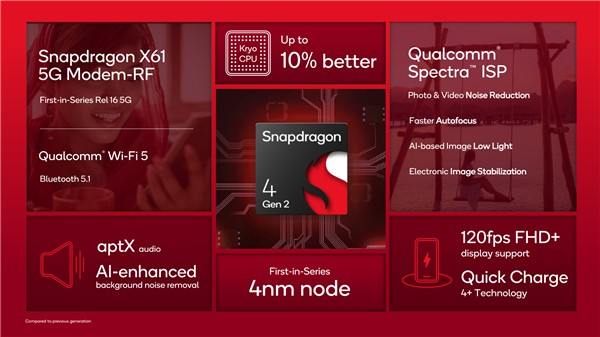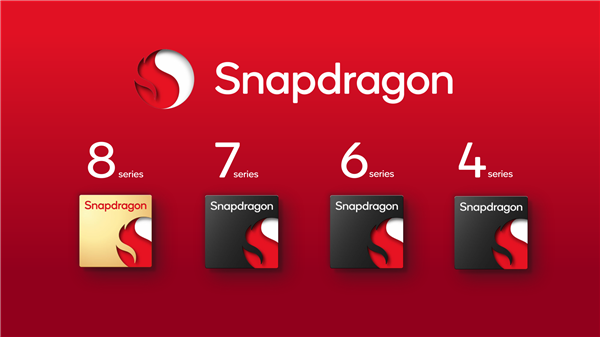 Technology peripherals
Technology peripherals
 It Industry
It Industry
 Qualcomm releases second-generation Snapdragon 4 mobile platform, bringing new upgrades to entry-level smartphones
Qualcomm releases second-generation Snapdragon 4 mobile platform, bringing new upgrades to entry-level smartphones
Qualcomm releases second-generation Snapdragon 4 mobile platform, bringing new upgrades to entry-level smartphones
According to news on June 27, Qualcomm officially released the second-generation Snapdragon 4 mobile platform (Snapdragon 4 Gen2), bringing a new upgrade to entry-level smartphones. According to the editor's understanding, this new platform has made breakthroughs in manufacturing technology, processor performance, photography capabilities and artificial intelligence.
First of all, in terms of manufacturing process, Qualcomm upgraded the Snapdragon 4 manufacturing process from last year's TSMC 6nm to Samsung's 4nm process, achieving more efficient chip manufacturing. This advancement helps improve the performance and power consumption of the chip.

Despite the performance improvements, the second-generation Snapdragon 4 still uses dual-core A78 and six-core A55 CPU configurations. Compared with the previous generation, the main frequency has been increased from 2.0 1.8GHz to 2.2 2.0GHz, making the processor run faster and bringing a smoother user experience.
In addition, Qualcomm has made some innovations in imaging. Snapdragon 4 Gen2 introduces multi-camera temporal filtering (MCTF) technology for the first time, which can perform high-quality noise reduction processing during video shooting and improve the clarity of video images. In addition, camera improvements include adjustments to the camera pixel configuration, supporting zero-shutter delay shooting with a single 108-megapixel lens or 32-megapixel lens, and upgrading the dual-camera configuration from 25-13 million pixels to 16-16 million pixels.

In terms of artificial intelligence, the second-generation Snapdragon 4 brings a number of enhanced features. The technology includes AI-based low-light photography, allowing users to take clear, detailed photos in low-light environments. In addition, the AI-enhanced background noise cancellation function can provide clear voice and video call effects in work or crowded environments, bringing users a better communication experience.
In addition to the above upgrades, the second-generation Snapdragon 4 also adds new memory and storage technologies. In terms of memory, it supports LPDDR4X-2133 and the first-introduced LPDDR5X-3200, providing higher bandwidth. In terms of storage, Snapdragon 4 Gen2 has been upgraded to faster UFS 3.1 storage, which is a significant improvement over the outdated eMMC 5.1.

In terms of connection performance, the second-generation Snapdragon 4 is equipped with the Snapdragon X61 baseband and supports 5G R16 standard. Although the network speed has not changed, it still supports 5G networks with a maximum download of 2500Mbps and an upload of 900Mbps, and a 4G network with a maximum download of 800Mbps and an upload of 210Mbps, but the millimeter wave band has been removed. However, strangely, the Bluetooth version has regressed from 5.2 to 5.1, which may result in the inability to support Bluetooth LE Audio function.
In the second half of this year, brands including Redmi and vivo are expected to launch new mobile phones equipped with the second-generation Snapdragon 4 mobile platform in their product lines. Users can expect an even better experience in terms of performance, photography, and artificial intelligence.
The above is the detailed content of Qualcomm releases second-generation Snapdragon 4 mobile platform, bringing new upgrades to entry-level smartphones. For more information, please follow other related articles on the PHP Chinese website!

Hot AI Tools

Undresser.AI Undress
AI-powered app for creating realistic nude photos

AI Clothes Remover
Online AI tool for removing clothes from photos.

Undress AI Tool
Undress images for free

Clothoff.io
AI clothes remover

Video Face Swap
Swap faces in any video effortlessly with our completely free AI face swap tool!

Hot Article

Hot Tools

Notepad++7.3.1
Easy-to-use and free code editor

SublimeText3 Chinese version
Chinese version, very easy to use

Zend Studio 13.0.1
Powerful PHP integrated development environment

Dreamweaver CS6
Visual web development tools

SublimeText3 Mac version
God-level code editing software (SublimeText3)

Hot Topics
 Bose launches new Ultra open-back headphones powered by Snapdragon Sound, supporting Qualcomm aptX Lossless audio and aptX Adapt
Feb 29, 2024 pm 07:10 PM
Bose launches new Ultra open-back headphones powered by Snapdragon Sound, supporting Qualcomm aptX Lossless audio and aptX Adapt
Feb 29, 2024 pm 07:10 PM
On February 15, Bose announced the launch of an audio wearable device built on the second-generation Qualcomm® S5 audio platform-Bose Ultra open headphones. The new product supports SnapdragonSound technology, providing users with an audio feast anytime, anywhere with lossless high-definition audio performance, fast and stable connection experience, and longer battery life. Bose has always provided users with the ultimate high-quality audio experience. Based on the second-generation Qualcomm S5 audio platform, the industry-leading SnapdragonSound technology brings Qualcomm aptX® Lossless audio and aptXAdaptive audio technology to the new BoseUltra open-back headphones.
 Transsion responds to Qualcomm's patent infringement lawsuit in India: The agreement has been signed and fulfilled
Jul 18, 2024 pm 03:03 PM
Transsion responds to Qualcomm's patent infringement lawsuit in India: The agreement has been signed and fulfilled
Jul 18, 2024 pm 03:03 PM
According to news on July 13, it was recently reported that Qualcomm is suing Transsion Holdings Group in the Delhi High Court in India, accusing the latter of infringing four of its non-standard essential patents. Transsion responded that it had signed a 5G standard patent license agreement with Qualcomm and was fulfilling the agreement. Transsion said that its sales network covers more than 70 countries in emerging markets such as Africa and South Asia. In some countries, some patent holders do not own or only own a small number of patents. However, it requires a globally unified rate and appeals for excessive licensing fees, which does not take into account the differences in economic development levels in different regions, the fact that it has no patents or only a small number of patents in specific regions or markets, and the existing cases provide different fees in different regions. rate and other factors. This practice does not fully comply with the principles of fairness, reasonableness and non-discrimination. Sound transmission
 The third generation of Snapdragon 7 makes a stunning debut: using advanced 4nm process and new CPU design to improve performance by 15%
Nov 18, 2023 pm 12:38 PM
The third generation of Snapdragon 7 makes a stunning debut: using advanced 4nm process and new CPU design to improve performance by 15%
Nov 18, 2023 pm 12:38 PM
Qualcomm held a grand press conference on the afternoon of November 17, officially launching a new mobile processor - Snapdragon 7Gen3. The official Chinese name is "Third Generation Snapdragon 7", corresponding to its latest 8 series products. The product planning of the new generation Snapdragon 7 series chips has begun to take shape, covering different models such as medium cup, large cup and extra large cup: Snapdragon 7s focuses on balanced energy efficiency, Snapdragon 7 is committed to providing an advanced experience, and Snapdragon 7+ pursues excellent performance. Using advanced TSMC 4nm process technology, its CPU is designed with 4 large and 4 small cores, including 1 core with a main frequency of 2.63GHz, 3 cores with a main frequency of 2.40GHz, and 2 cores with a main frequency of 1.80GHz. Compared with the previous generation Snapdragon 7, performance has been improved
 All 5 major manufacturers use it! Qualcomm's third-generation Snapdragon 8s can be understood in one picture: the third-generation Snapdragon 8 has the same origin
Mar 18, 2024 pm 07:30 PM
All 5 major manufacturers use it! Qualcomm's third-generation Snapdragon 8s can be understood in one picture: the third-generation Snapdragon 8 has the same origin
Mar 18, 2024 pm 07:30 PM
According to news on March 18, this afternoon Qualcomm officially released Snapdragon 8sGen3, which is named the third generation Snapdragon 8s in Chinese. At the meeting, Qualcomm directly announced that Xiaomi Civi4 series will make the world premiere of this processor. The reason why the third generation Snapdragon 8s is named is because it is completely from the same origin as the third generation Snapdragon 8, using the 4nm process, and the CPU is 1×3.0GHz Cortex-X4 4×2.8GHz Cortex-A720 3×2.0GHz Cortex-A520 , the GPU is Adreno735. The CPU is completely the same as the third-generation Snapdragon 8 architecture, while the GPU is the same model as the second-generation Snapdragon 8, and supports new hardware ray tracing, Adren
 Qualcomm releases second-generation Snapdragon 4 mobile platform, bringing new upgrades to entry-level smartphones
Jun 27, 2023 pm 12:06 PM
Qualcomm releases second-generation Snapdragon 4 mobile platform, bringing new upgrades to entry-level smartphones
Jun 27, 2023 pm 12:06 PM
According to news on June 27, Qualcomm officially released the second-generation Snapdragon 4 mobile platform (Snapdragon 4Gen2) today, bringing a new upgrade to entry-level smartphones. According to the editor's understanding, this new platform has made breakthroughs in manufacturing technology, processor performance, photography capabilities and artificial intelligence. First of all, in terms of manufacturing technology, Qualcomm upgraded the manufacturing process of Snapdragon 4 from last year's TSMC 6-nanometer process to Samsung's 4-nanometer process, achieving more efficient chip manufacturing. This advancement helps improve the performance and power consumption of the chip. In terms of processor, the second-generation Snapdragon 4 retains the dual-core A78 and six-core A55 CPU configurations, but the frequency has been increased. Compared with the previous generation, the main frequency has been increased from 2.0+1.8GHz to 2.2+2.0GHz, making
 Built on TSMC's 4nm process, Qualcomm Snapdragon 7 Gen3 specifications are revealed, and its performance is lagging behind last year's Snapdragon 7+ Gen2
Nov 14, 2023 pm 08:17 PM
Built on TSMC's 4nm process, Qualcomm Snapdragon 7 Gen3 specifications are revealed, and its performance is lagging behind last year's Snapdragon 7+ Gen2
Nov 14, 2023 pm 08:17 PM
According to news on November 14, recently, the digital chat station exposed the detailed specifications of Qualcomm Snapdragon 7Gen3. The chip uses TSMC's 4nm process and is characterized by a 1+3+4 architecture design, which is similar to the Snapdragon 7+Gen2. The CPU part is composed of 1×2.63GHz+3×2.4GHz+4×1.8GHz. The main core is ArmCortex-A715 and equipped with Adreno720GPU. In comparison, the CPU configuration of Qualcomm Snapdragon 7+Gen2 is 1×2.91GHz+3×2.49GHz+4×1.8GHz, equipped with Adreno725 GPU. As far as the editor understands, from the comparison of specifications, the overall performance of Qualcomm Snapdragon 7Gen3 is not as good as that of the Snapdragon 7 Gen3 launched this year.
 Qualcomm announced a new chapter in mobility at CES 2024. More than 350 million cars have adopted Snapdragon digital chassis.
Jan 12, 2024 pm 01:09 PM
Qualcomm announced a new chapter in mobility at CES 2024. More than 350 million cars have adopted Snapdragon digital chassis.
Jan 12, 2024 pm 01:09 PM
At the recent CES2024 International Consumer Electronics Show, Qualcomm announced that it would lead the travel industry into a new era. Qualcomm revealed that to date, more than 350 million cars worldwide have adopted its Snapdragon digital chassis solutions, while more than 40 million cars are equipped with the Snapdragon cockpit platform. This feat demonstrates Qualcomm’s strong strength and broad influence in the field of automotive technology. Snapdragon Digital Chassis' continued strong growth is driven by its complete product portfolio for next-generation generative artificial intelligence. These products cover many aspects such as digital cockpit, Internet of Vehicles technology, Internet services, and advanced driving assistance and autonomous driving systems. The product portfolio of Snapdragon Digital Chassis not only provides optimized solutions for vehicles, but also gives vehicles open and programmable capabilities.
 2023 Service Trade Fair: Qualcomm releases 'Hybrid AI is the future of AI' white paper
Sep 06, 2023 pm 01:41 PM
2023 Service Trade Fair: Qualcomm releases 'Hybrid AI is the future of AI' white paper
Sep 06, 2023 pm 01:41 PM
On September 5, with the help of the 2023 China International Fair for Trade in Services (hereinafter referred to as the "Service Trade Fair") results release platform, Qualcomm (Qualcomm) released the artificial intelligence (AI) white paper - "Hybrid" offline at the National Convention Center. AI is the future of AI”. Hou Mingjuan, Global Vice President of Qualcomm Incorporated, delivered a speech. Hou Mingjuan, Global Vice President of Qualcomm Incorporated, said at the meeting, "As generative AI brings unprecedented innovation and development opportunities, AI is rapidly entering people's lives with an astonishing development speed and strong innovation potential. In all aspects of work and life, its trend of transforming thousands of industries is becoming increasingly obvious. On-device AI is the key to realizing hybrid AI architecture and expanding generative AI to a wider range of the world. We look forward to working with more partners to achieve new,





